Business Modeling and Analysis: Initiative Impact Report - FIN60003
VerifiedAdded on 2023/06/03
|24
|2779
|56
Report
AI Summary
This report analyzes the effectiveness of initiatives undertaken by Margaret, using descriptive and inferential statistics on a sample of 100 employees from a population of 810. The analysis includes confidence interval estimation for average employee age and social media usage, indicating the sample's representativeness. Hypothesis testing suggests social media usage is independent of gender and new initiatives increased peer support without significantly altering stress levels. Regression analysis reveals a negative correlation between social media time and productivity, but no significant relationship with job satisfaction. The report concludes with limitations regarding sampling techniques, data accuracy, and ethical considerations, such as informed consent.
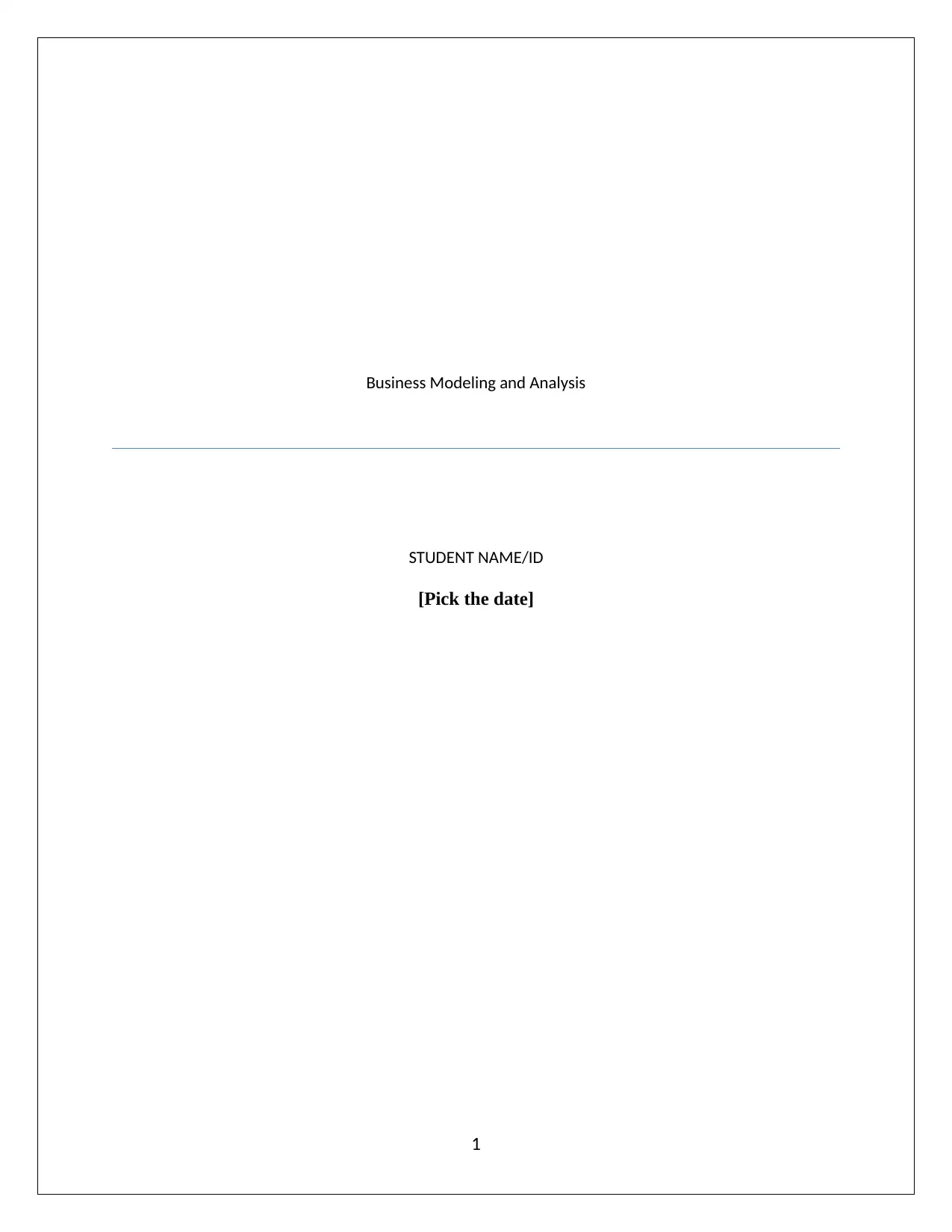
Business Modeling and Analysis
STUDENT NAME/ID
[Pick the date]
1
STUDENT NAME/ID
[Pick the date]
1
Paraphrase This Document
Need a fresh take? Get an instant paraphrase of this document with our AI Paraphraser
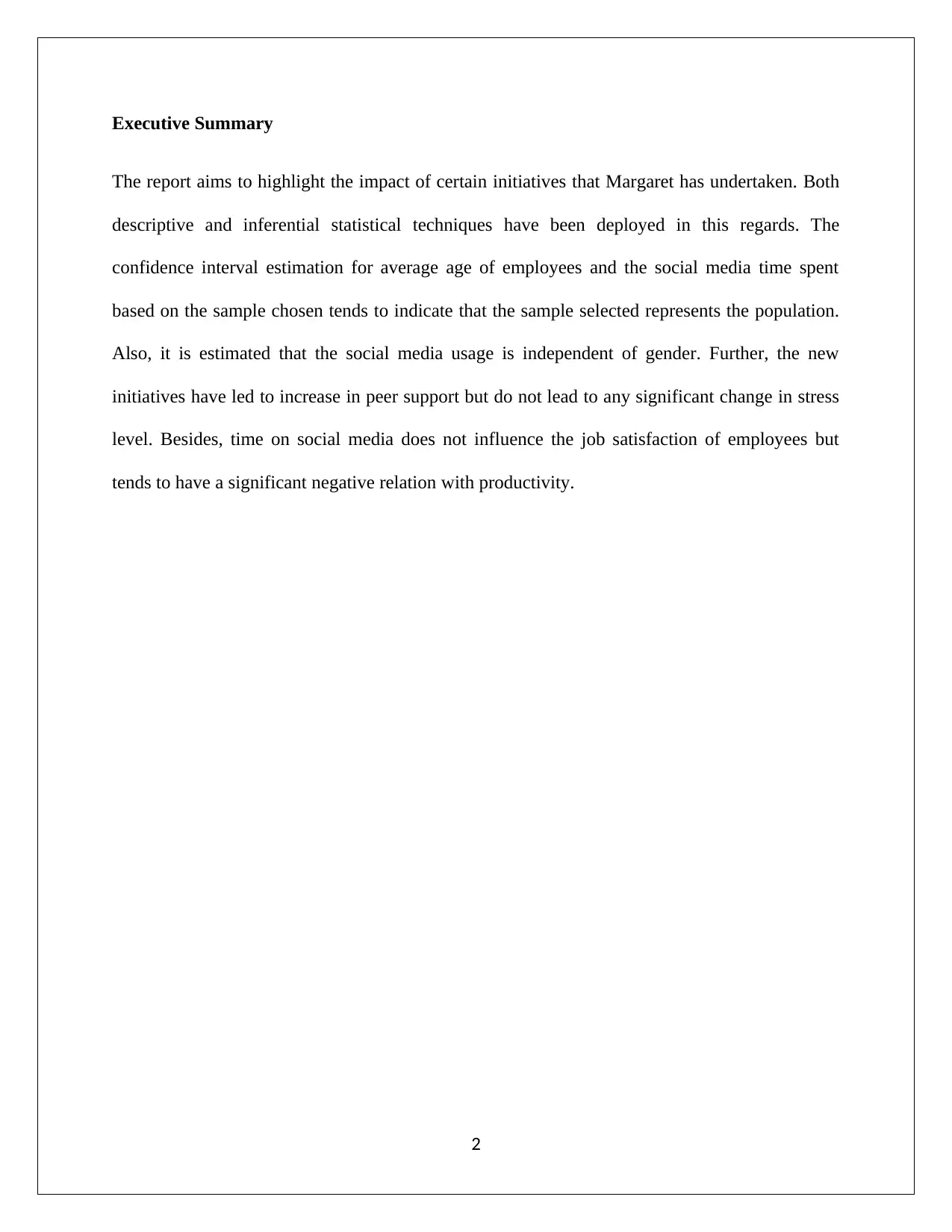
Executive Summary
The report aims to highlight the impact of certain initiatives that Margaret has undertaken. Both
descriptive and inferential statistical techniques have been deployed in this regards. The
confidence interval estimation for average age of employees and the social media time spent
based on the sample chosen tends to indicate that the sample selected represents the population.
Also, it is estimated that the social media usage is independent of gender. Further, the new
initiatives have led to increase in peer support but do not lead to any significant change in stress
level. Besides, time on social media does not influence the job satisfaction of employees but
tends to have a significant negative relation with productivity.
2
The report aims to highlight the impact of certain initiatives that Margaret has undertaken. Both
descriptive and inferential statistical techniques have been deployed in this regards. The
confidence interval estimation for average age of employees and the social media time spent
based on the sample chosen tends to indicate that the sample selected represents the population.
Also, it is estimated that the social media usage is independent of gender. Further, the new
initiatives have led to increase in peer support but do not lead to any significant change in stress
level. Besides, time on social media does not influence the job satisfaction of employees but
tends to have a significant negative relation with productivity.
2

Introduction
The objective of this report is to analyse the effectiveness of the various initiatives that have been
undertaken by Margaret. Various variables such as job satisfaction, peer support have been
measured after and before these initiatives so that statistical analysis can be performed for
estimation of their respective performance. In order to measure the same, a random sample of
100 employees has been used instead of the population of 810 employees. This sample data can
be found in the Appendix section. Both descriptive and inferential statistical techniques have
been deployed.
Task 1
A random sample of 100 observations has been derived from the given population 810
observations and would be used for requisite analysis. The random sample has been represented
in the appendix. The variables of interest are highlighted below.
Gender of employee
Age of employee (Years)
Time spent on social media (Hours per day)
Productivity (Number of billable hours)
Job satisfaction (Scale 1 to 10 where 1 represents lowest level of satisfaction and 10
represents highest level of satisfaction)
Stress level (Scale 1 to 10 where 1 represents least stress level and 10 represents highest
stress level)
Peer support (Scale 1 to 10 where 1 represents least peer support and 10 represents highest
peer support)
3
The objective of this report is to analyse the effectiveness of the various initiatives that have been
undertaken by Margaret. Various variables such as job satisfaction, peer support have been
measured after and before these initiatives so that statistical analysis can be performed for
estimation of their respective performance. In order to measure the same, a random sample of
100 employees has been used instead of the population of 810 employees. This sample data can
be found in the Appendix section. Both descriptive and inferential statistical techniques have
been deployed.
Task 1
A random sample of 100 observations has been derived from the given population 810
observations and would be used for requisite analysis. The random sample has been represented
in the appendix. The variables of interest are highlighted below.
Gender of employee
Age of employee (Years)
Time spent on social media (Hours per day)
Productivity (Number of billable hours)
Job satisfaction (Scale 1 to 10 where 1 represents lowest level of satisfaction and 10
represents highest level of satisfaction)
Stress level (Scale 1 to 10 where 1 represents least stress level and 10 represents highest
stress level)
Peer support (Scale 1 to 10 where 1 represents least peer support and 10 represents highest
peer support)
3
⊘ This is a preview!⊘
Do you want full access?
Subscribe today to unlock all pages.

Trusted by 1+ million students worldwide

Task 2
The numerical summary and graphical representation of the variables is highlighted below.
Gender
It is apparent from the above shown pie chart that the distribution of gender in the sample has
been found as 45% and 55% for male and female employee respectively. It indicates that number
of female employees is higher than male employee which represents that in the population of 810
employees, the dominant portion of the employee working in the company could be female
employee assuming a representative sample (Eriksson and Kovalainen, 2015).
Age
4
The numerical summary and graphical representation of the variables is highlighted below.
Gender
It is apparent from the above shown pie chart that the distribution of gender in the sample has
been found as 45% and 55% for male and female employee respectively. It indicates that number
of female employees is higher than male employee which represents that in the population of 810
employees, the dominant portion of the employee working in the company could be female
employee assuming a representative sample (Eriksson and Kovalainen, 2015).
Age
4
Paraphrase This Document
Need a fresh take? Get an instant paraphrase of this document with our AI Paraphraser
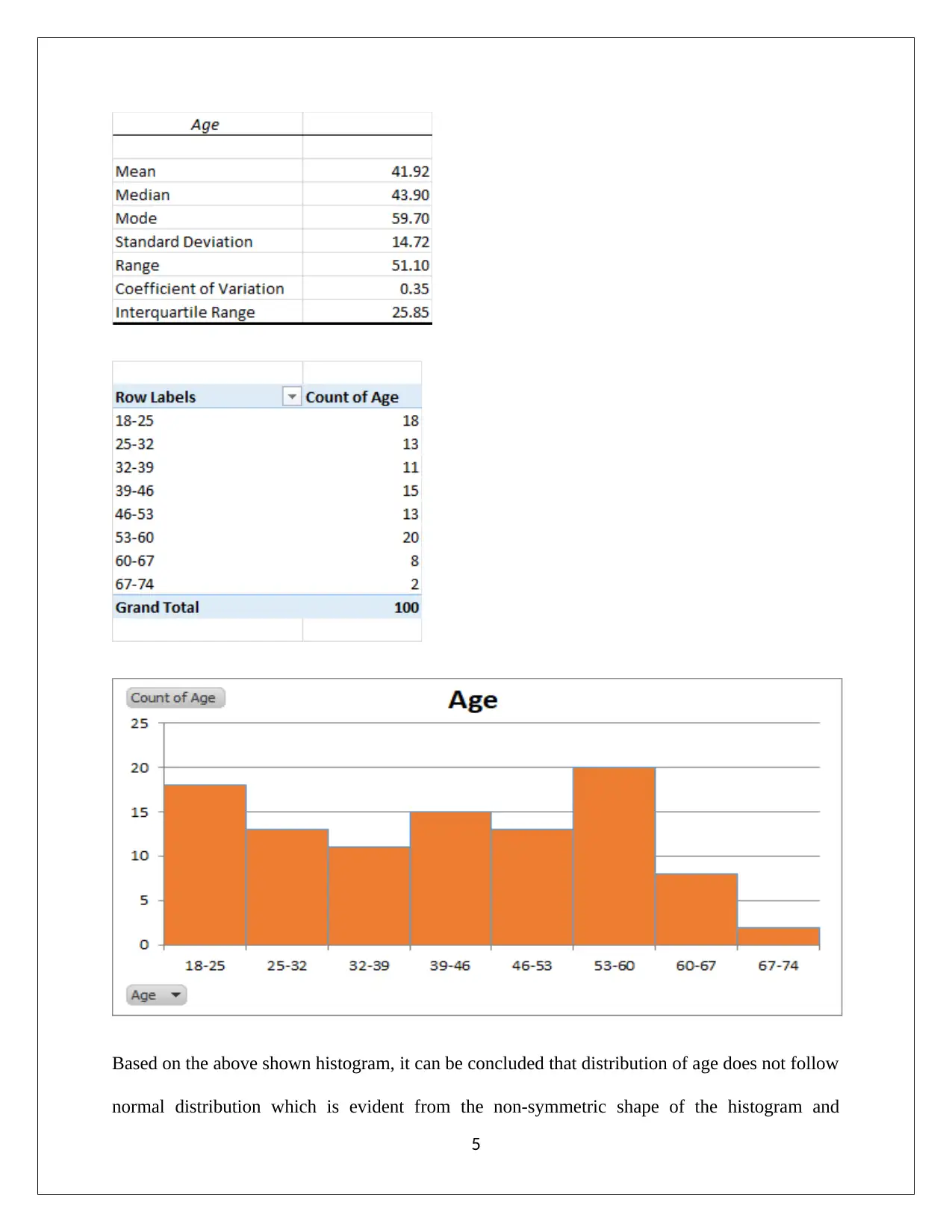
Based on the above shown histogram, it can be concluded that distribution of age does not follow
normal distribution which is evident from the non-symmetric shape of the histogram and
5
normal distribution which is evident from the non-symmetric shape of the histogram and
5
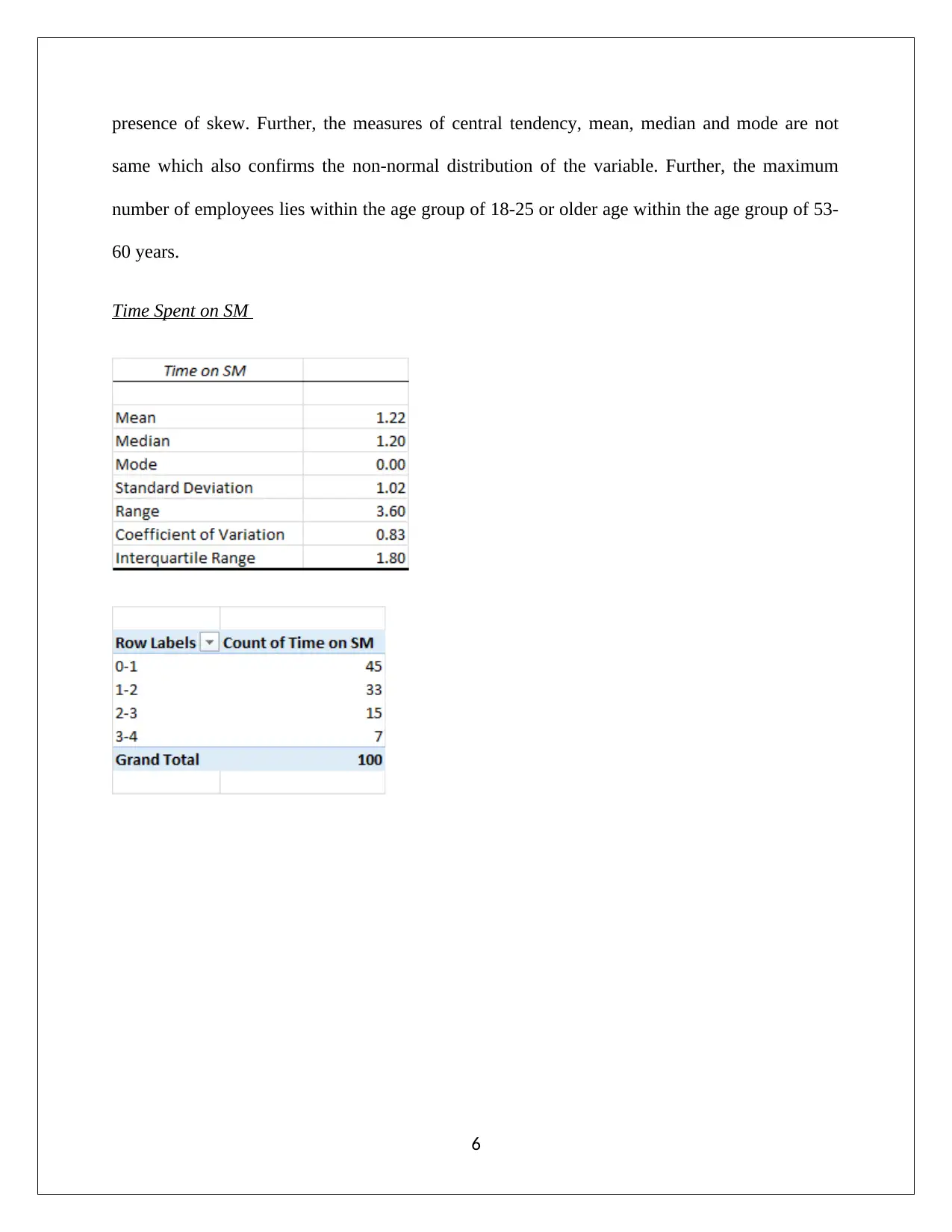
presence of skew. Further, the measures of central tendency, mean, median and mode are not
same which also confirms the non-normal distribution of the variable. Further, the maximum
number of employees lies within the age group of 18-25 or older age within the age group of 53-
60 years.
Time Spent on SM
6
same which also confirms the non-normal distribution of the variable. Further, the maximum
number of employees lies within the age group of 18-25 or older age within the age group of 53-
60 years.
Time Spent on SM
6
⊘ This is a preview!⊘
Do you want full access?
Subscribe today to unlock all pages.

Trusted by 1+ million students worldwide
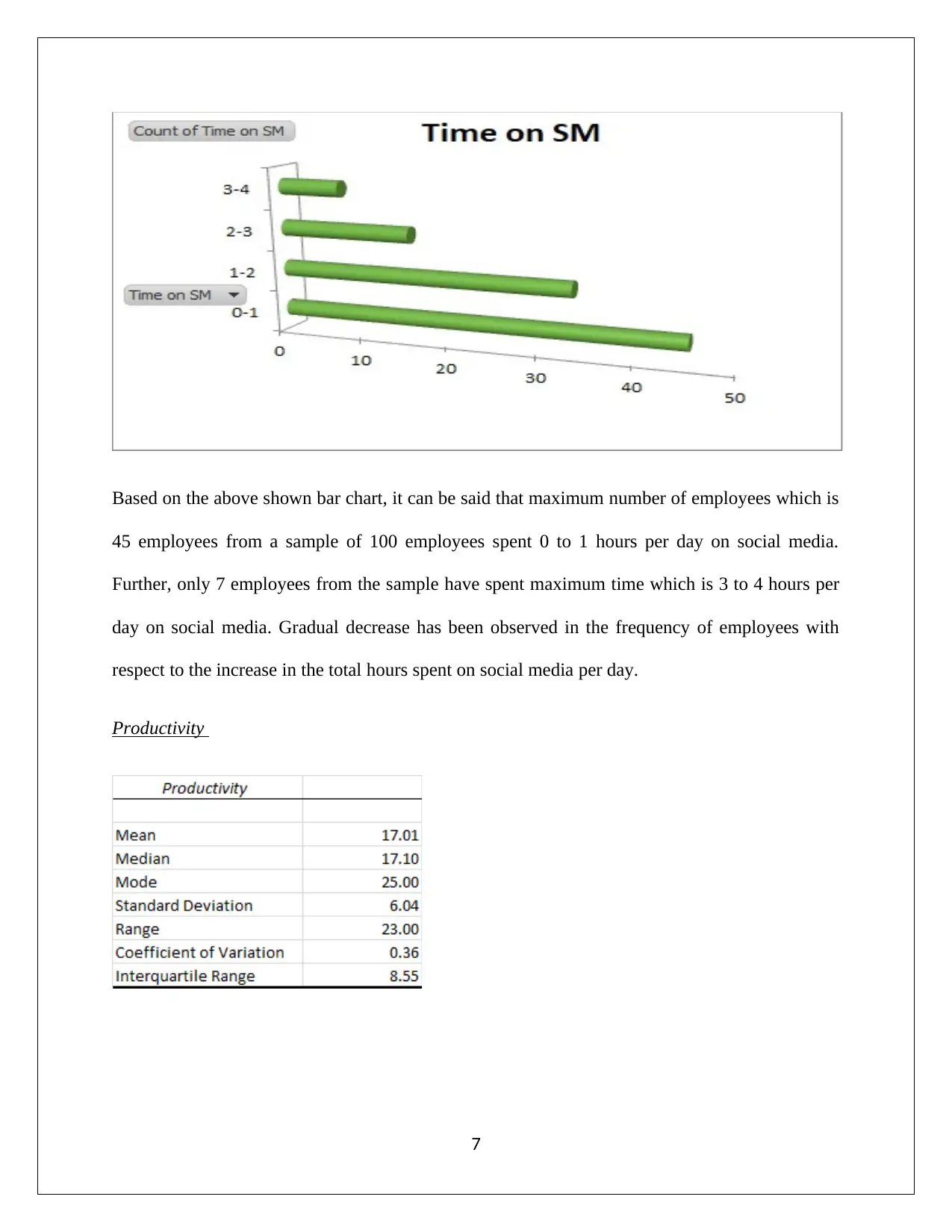
Based on the above shown bar chart, it can be said that maximum number of employees which is
45 employees from a sample of 100 employees spent 0 to 1 hours per day on social media.
Further, only 7 employees from the sample have spent maximum time which is 3 to 4 hours per
day on social media. Gradual decrease has been observed in the frequency of employees with
respect to the increase in the total hours spent on social media per day.
Productivity
7
45 employees from a sample of 100 employees spent 0 to 1 hours per day on social media.
Further, only 7 employees from the sample have spent maximum time which is 3 to 4 hours per
day on social media. Gradual decrease has been observed in the frequency of employees with
respect to the increase in the total hours spent on social media per day.
Productivity
7
Paraphrase This Document
Need a fresh take? Get an instant paraphrase of this document with our AI Paraphraser
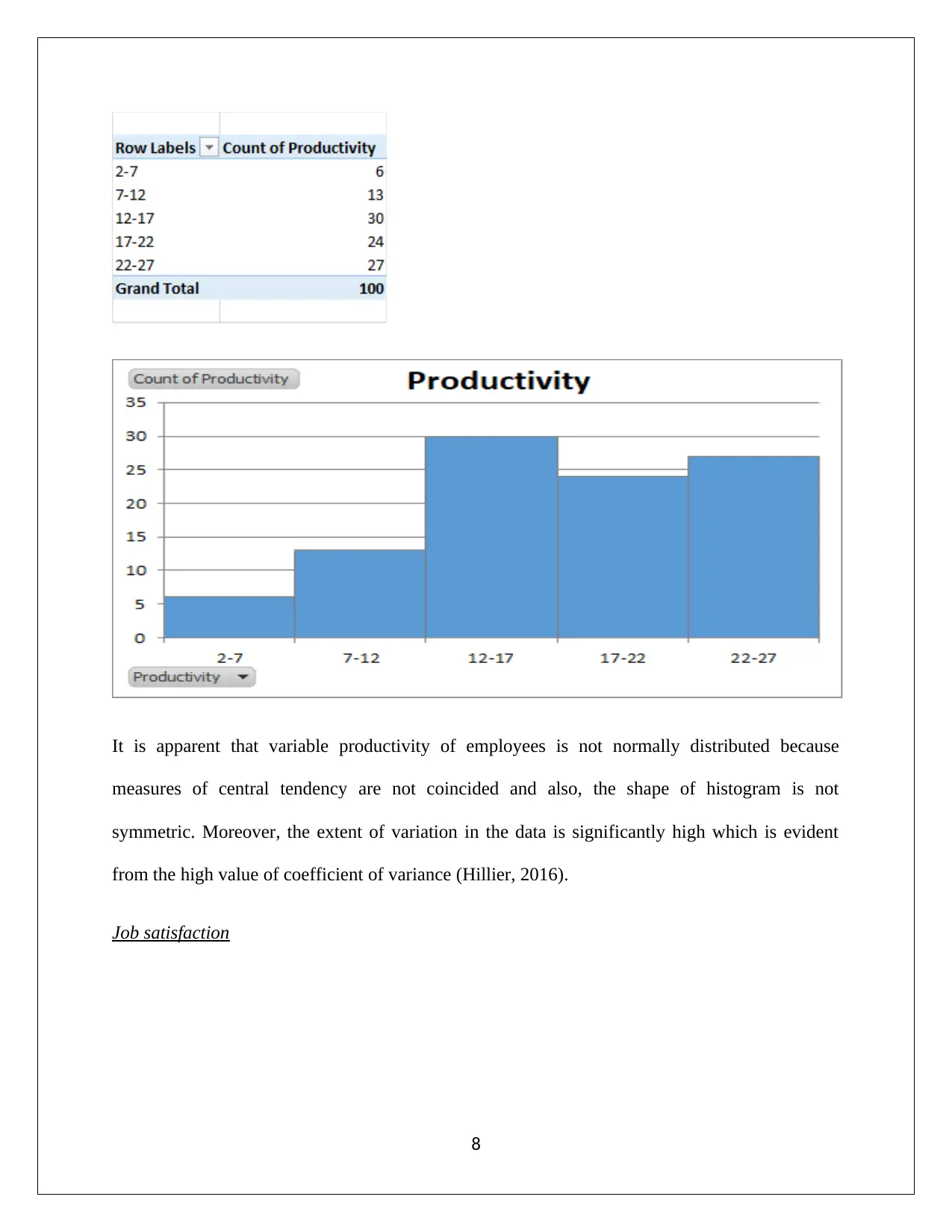
It is apparent that variable productivity of employees is not normally distributed because
measures of central tendency are not coincided and also, the shape of histogram is not
symmetric. Moreover, the extent of variation in the data is significantly high which is evident
from the high value of coefficient of variance (Hillier, 2016).
Job satisfaction
8
measures of central tendency are not coincided and also, the shape of histogram is not
symmetric. Moreover, the extent of variation in the data is significantly high which is evident
from the high value of coefficient of variance (Hillier, 2016).
Job satisfaction
8
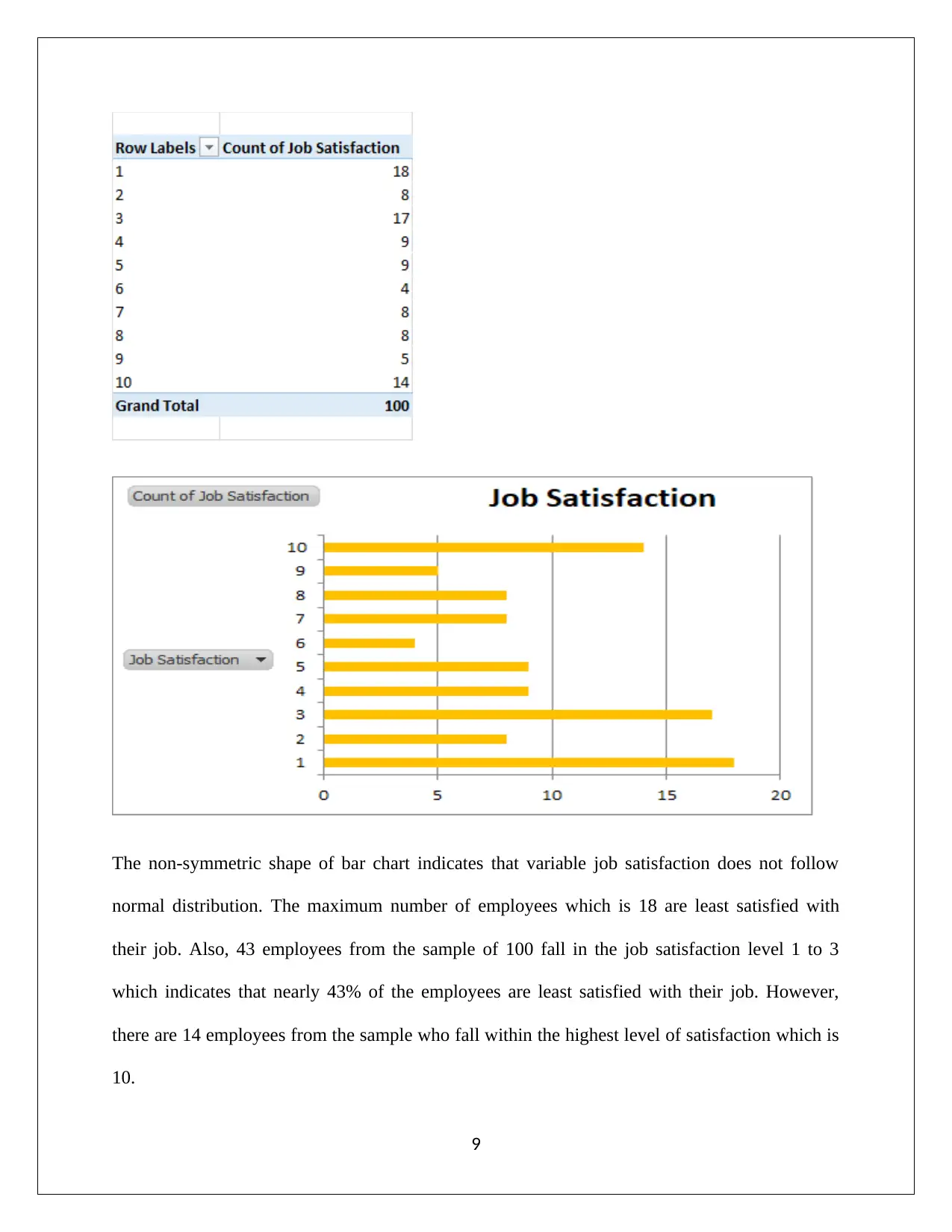
The non-symmetric shape of bar chart indicates that variable job satisfaction does not follow
normal distribution. The maximum number of employees which is 18 are least satisfied with
their job. Also, 43 employees from the sample of 100 fall in the job satisfaction level 1 to 3
which indicates that nearly 43% of the employees are least satisfied with their job. However,
there are 14 employees from the sample who fall within the highest level of satisfaction which is
10.
9
normal distribution. The maximum number of employees which is 18 are least satisfied with
their job. Also, 43 employees from the sample of 100 fall in the job satisfaction level 1 to 3
which indicates that nearly 43% of the employees are least satisfied with their job. However,
there are 14 employees from the sample who fall within the highest level of satisfaction which is
10.
9
⊘ This is a preview!⊘
Do you want full access?
Subscribe today to unlock all pages.

Trusted by 1+ million students worldwide
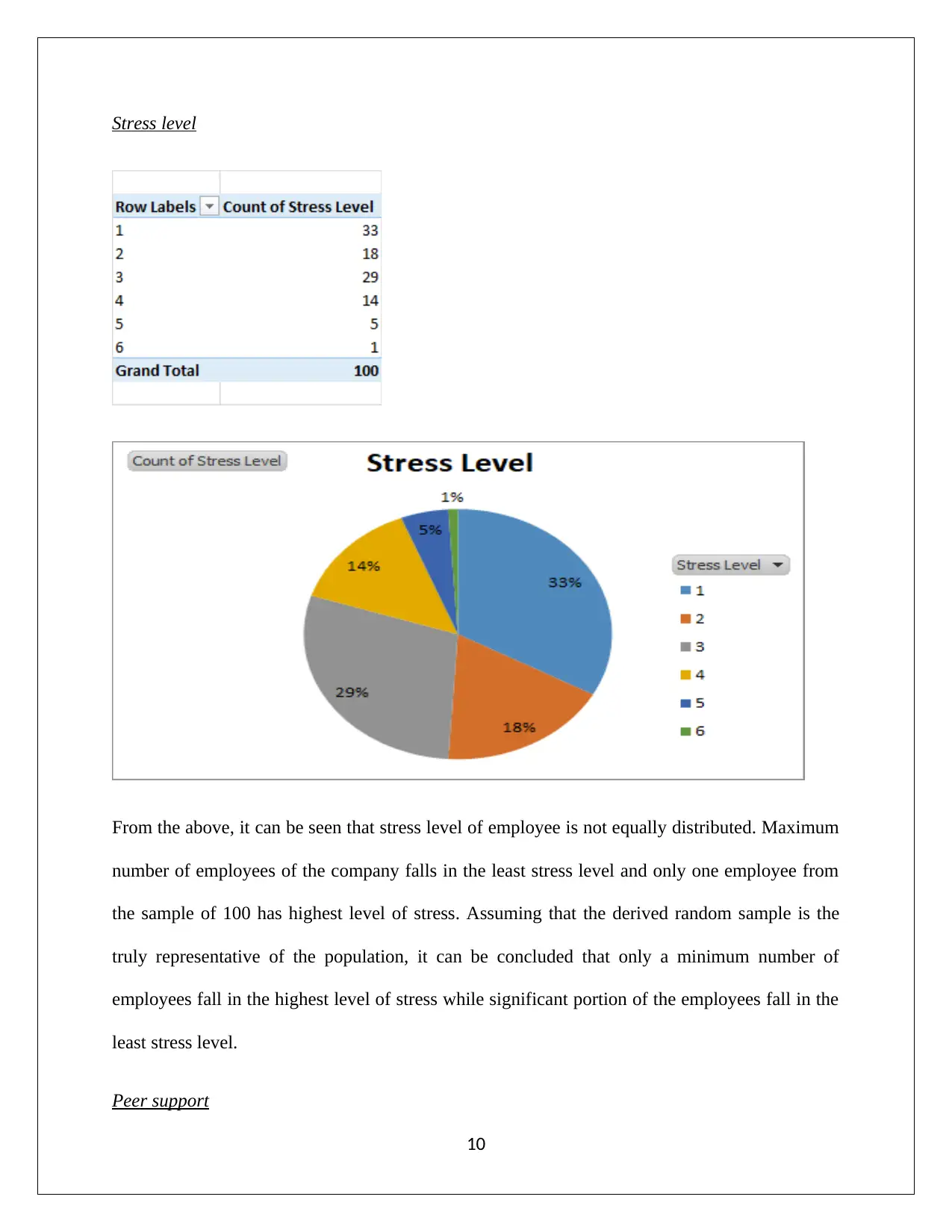
Stress level
From the above, it can be seen that stress level of employee is not equally distributed. Maximum
number of employees of the company falls in the least stress level and only one employee from
the sample of 100 has highest level of stress. Assuming that the derived random sample is the
truly representative of the population, it can be concluded that only a minimum number of
employees fall in the highest level of stress while significant portion of the employees fall in the
least stress level.
Peer support
10
From the above, it can be seen that stress level of employee is not equally distributed. Maximum
number of employees of the company falls in the least stress level and only one employee from
the sample of 100 has highest level of stress. Assuming that the derived random sample is the
truly representative of the population, it can be concluded that only a minimum number of
employees fall in the highest level of stress while significant portion of the employees fall in the
least stress level.
Peer support
10
Paraphrase This Document
Need a fresh take? Get an instant paraphrase of this document with our AI Paraphraser
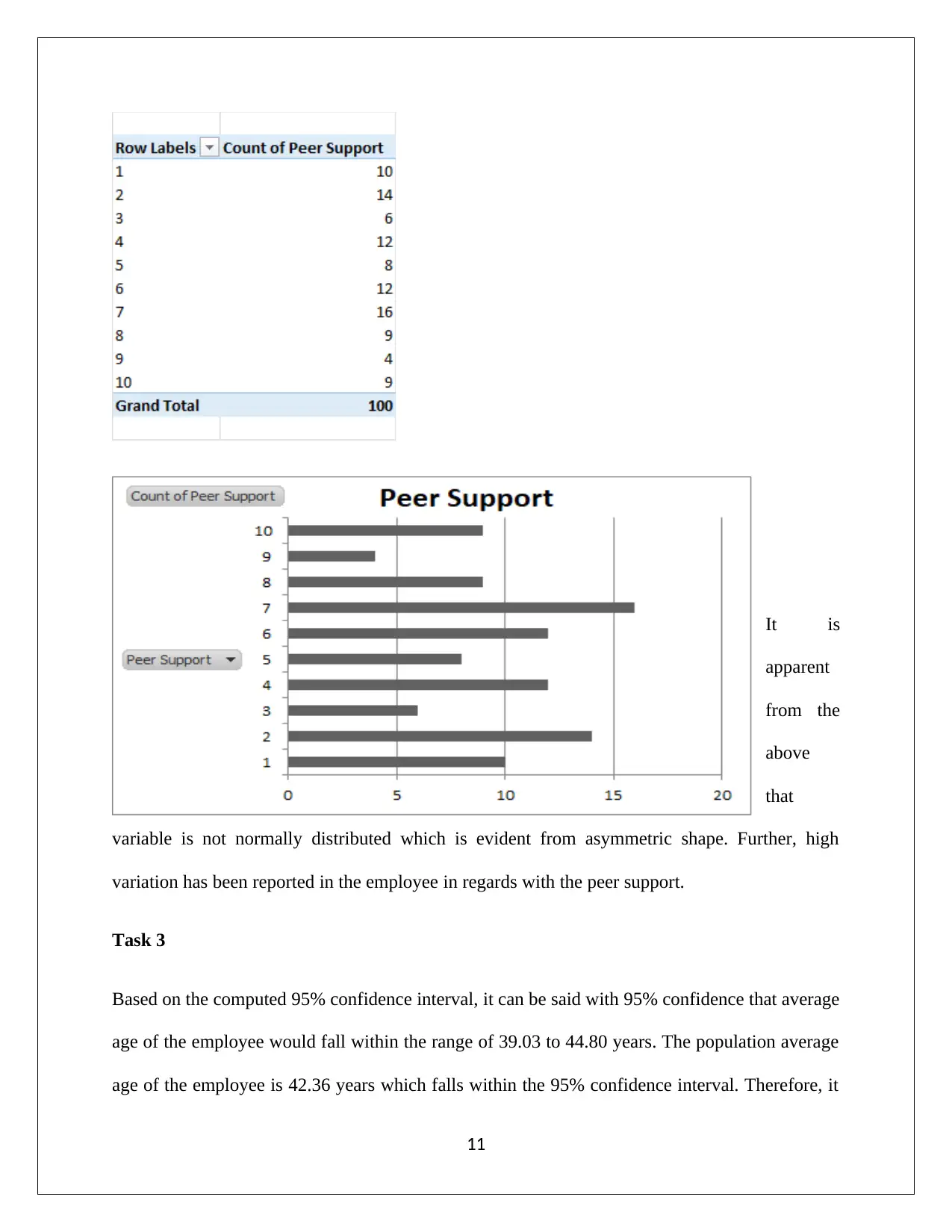
It is
apparent
from the
above
that
variable is not normally distributed which is evident from asymmetric shape. Further, high
variation has been reported in the employee in regards with the peer support.
Task 3
Based on the computed 95% confidence interval, it can be said with 95% confidence that average
age of the employee would fall within the range of 39.03 to 44.80 years. The population average
age of the employee is 42.36 years which falls within the 95% confidence interval. Therefore, it
11
apparent
from the
above
that
variable is not normally distributed which is evident from asymmetric shape. Further, high
variation has been reported in the employee in regards with the peer support.
Task 3
Based on the computed 95% confidence interval, it can be said with 95% confidence that average
age of the employee would fall within the range of 39.03 to 44.80 years. The population average
age of the employee is 42.36 years which falls within the 95% confidence interval. Therefore, it
11
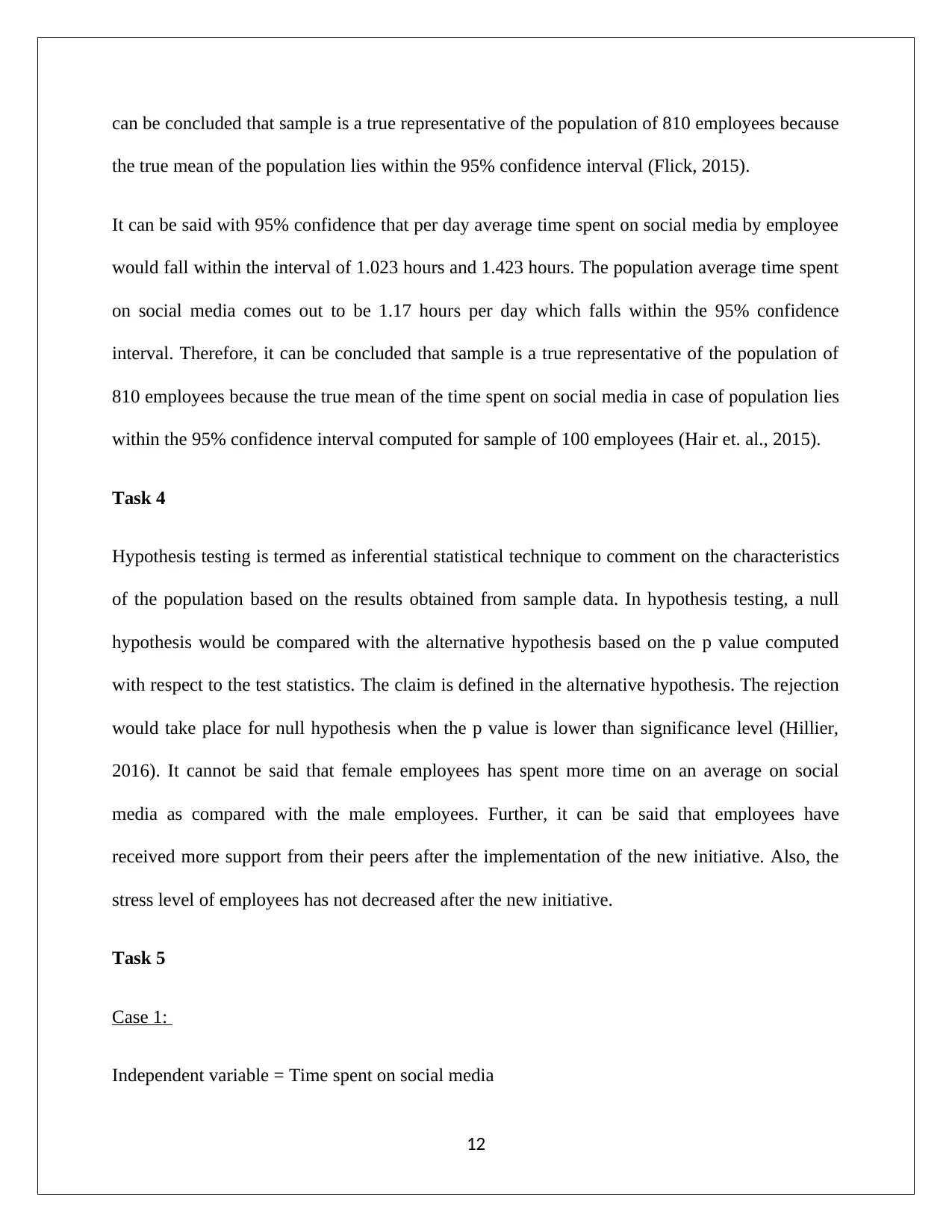
can be concluded that sample is a true representative of the population of 810 employees because
the true mean of the population lies within the 95% confidence interval (Flick, 2015).
It can be said with 95% confidence that per day average time spent on social media by employee
would fall within the interval of 1.023 hours and 1.423 hours. The population average time spent
on social media comes out to be 1.17 hours per day which falls within the 95% confidence
interval. Therefore, it can be concluded that sample is a true representative of the population of
810 employees because the true mean of the time spent on social media in case of population lies
within the 95% confidence interval computed for sample of 100 employees (Hair et. al., 2015).
Task 4
Hypothesis testing is termed as inferential statistical technique to comment on the characteristics
of the population based on the results obtained from sample data. In hypothesis testing, a null
hypothesis would be compared with the alternative hypothesis based on the p value computed
with respect to the test statistics. The claim is defined in the alternative hypothesis. The rejection
would take place for null hypothesis when the p value is lower than significance level (Hillier,
2016). It cannot be said that female employees has spent more time on an average on social
media as compared with the male employees. Further, it can be said that employees have
received more support from their peers after the implementation of the new initiative. Also, the
stress level of employees has not decreased after the new initiative.
Task 5
Case 1:
Independent variable = Time spent on social media
12
the true mean of the population lies within the 95% confidence interval (Flick, 2015).
It can be said with 95% confidence that per day average time spent on social media by employee
would fall within the interval of 1.023 hours and 1.423 hours. The population average time spent
on social media comes out to be 1.17 hours per day which falls within the 95% confidence
interval. Therefore, it can be concluded that sample is a true representative of the population of
810 employees because the true mean of the time spent on social media in case of population lies
within the 95% confidence interval computed for sample of 100 employees (Hair et. al., 2015).
Task 4
Hypothesis testing is termed as inferential statistical technique to comment on the characteristics
of the population based on the results obtained from sample data. In hypothesis testing, a null
hypothesis would be compared with the alternative hypothesis based on the p value computed
with respect to the test statistics. The claim is defined in the alternative hypothesis. The rejection
would take place for null hypothesis when the p value is lower than significance level (Hillier,
2016). It cannot be said that female employees has spent more time on an average on social
media as compared with the male employees. Further, it can be said that employees have
received more support from their peers after the implementation of the new initiative. Also, the
stress level of employees has not decreased after the new initiative.
Task 5
Case 1:
Independent variable = Time spent on social media
12
⊘ This is a preview!⊘
Do you want full access?
Subscribe today to unlock all pages.

Trusted by 1+ million students worldwide
1 out of 24
Related Documents
Your All-in-One AI-Powered Toolkit for Academic Success.
+13062052269
info@desklib.com
Available 24*7 on WhatsApp / Email
![[object Object]](/_next/static/media/star-bottom.7253800d.svg)
Unlock your academic potential
Copyright © 2020–2026 A2Z Services. All Rights Reserved. Developed and managed by ZUCOL.




